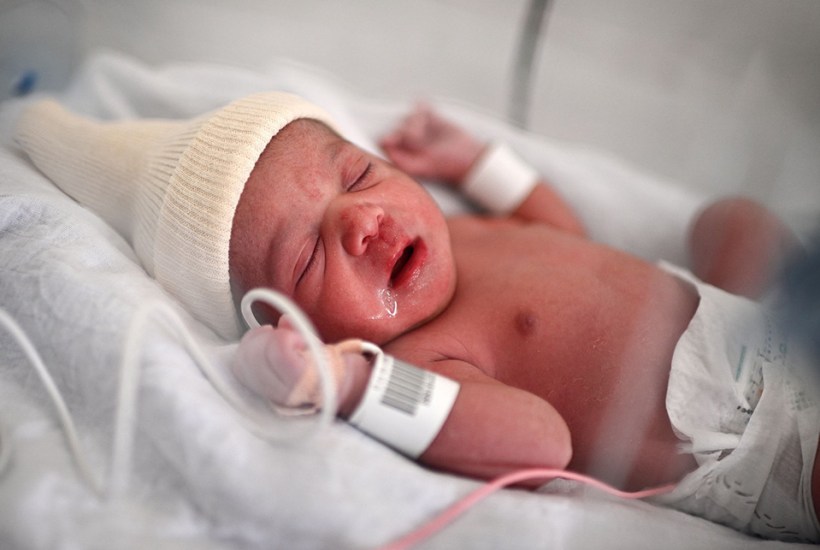The Spectator Australia is one of the few publications to report the significant drop in live birth rates occurring in some developed nations. Germany’s Federal Bureau of Statistics documented a reduction of over 12 per cent and similar falls have been reported in Switzerland, Sweden, Taiwan, the UK, Slovenia, and some US states. In other countries – the Netherlands, Belgium, and Portugal – this is not the case but given the temporal association with the Covid pandemic we should investigate the matter seriously.
Start with the basics. A reduction in population fertility may be due to fewer pregnancies, or increased pregnancy failures and both could be caused by viral infection, societal adaptation, or adverse effects of medical interventions.
Looking at viral infections, several micro-organisms can damage the unborn at different phases of intrauterine life. Rubella, for example, causes abortions, stillbirths, and malformations. So, a viral pandemic could reduce live birth rates. This is unlikely with Covid as intrauterine infection appears to be rare and a direct effect should already be evident. Still, here’s a research question:
Are Covid cases and hospital admissions associated with a reduction in live births six to eight months later?
Societal adaptation to the pandemic – more stress, less sex, less IVF, more terminations – could cause a decline in fertility. It’s happened before. After Chernobyl there were hundreds of thousands of additional terminations in Europe, but weren’t people more stressed in 2020 than in 2021? If so, it should have led to a drop in live births between late 2020 and mid 2021. So, here’s another research question:
Was there an increase in pregnancy terminations and/or fewer fertility treatment associated with a reduction in live births 6-9 months later?
The third possibility is that a fall in fertility could be an adverse effect of a medical intervention. There are precedents. Thalidomide was launched in 1956. At the time, it was known that medications might affect the unborn, but there was no mandatory testing for such effects. The principles of reproductive toxicology were only defined in 1959: depending on gestational age at exposure there might be a miscarriage or stillbirth, malformations, intrauterine growth retardation or functional disturbances only apparent in childhood or beyond.
Thalidomide resulted in about 10,000 cases of limb malformations. Once Widukind Lenz in Germany and William McBride in Sydney sounded the alarm in November 1961, the drug was no longer given to pregnant women. Thalidomide studies in animals form the basis of modern reproductive toxicology. Increasingly, agencies were tasked with regulating the clinical testing of new drugs. Since 1990 there have been international standards, but scandals still happen. Merck’s drug Vioxx caused up to 140,000 heart attacks prior to withdrawal.
Testing drugs on pregnant animals is mandatory and drug trials almost always exclude pregnant women to minimise risks. With most Covid vaccine trials, pregnant women were excluded. Pregnant women are now being encouraged to be immunised in what amounts to a real-life experiment. It led to a joke. One lab rat asks another, ‘Been immunised yet?’ ‘No,’ the rat replies, ‘They’re still testing it on humans.’ Make that pregnant humans.
Could immunisation impact live birth rates? Biodistribution studies of injected nanoparticles show that they do not remain in the deltoid muscle, accumulating in several sites, including the ovaries. This may influence ovarian function, and menstrual disturbances are a well-documented adverse effect. Sperm production may also be affected. Even if a pregnancy starts, the result may be implantation failure, a subclinical miscarriage or a clinically overt first trimester miscarriage. These normally occur in 12 to 15 per cent of confirmed pregnancies. Second-trimester miscarriages and stillbirths are much rarer. That doesn’t mean later immunisation is harmless but to date there is only anecdotal information. Toxic effects in the first trimester are most likely at four to eight weeks and could increase miscarriages and reduce live births seven to eight months later. This would be a temporary effect (as was the effect of Thalidomide). There is some evidence in publicly available data that this might be occuring following the mass vaccination of women of reproductive age in 2021-22, potentially affecting live birth rates from early 2022. So, here’s a research question:
Is there a temporal association between vaccination campaigns, first trimester miscarriages and live birth rates seven to eight months later?
There are other issues. Documented menstrual irregularities suggest a disturbance of ovarian or uterine function. A possible consequence would be an increase in premature menopause. Other consequences may take longer to manifest. Given that conditions such as myocarditis and blood clots are recognised adverse effects of some Covid vaccines, are there similar effects in the unborn? There is a precedent. It took over 30 years for the effects of stilbestrol – an estrogen treatment used in pregnancy – to become evident; it caused cancer in the offspring of patients.
Academic physicians don’t normally publish anonymously but regulators, health ministries and professional organisations refuse to ask, let alone try to answer, the questions posed here and wage smear campaigns against those who do. Papers published in reputable journals are at times indistinguishable from propaganda.
In the face of widespread systemic failure, the principles ‘My body, my choice’ and ‘First do no harm’ should put an immediate end to Covid vaccination of women of reproductive age. And then let’s hope the blind hysteria of postmodern media, politics and medicine has not caused the worst medical disaster in human history.
Got something to add? Join the discussion and comment below.
Get 10 issues for just $10
Subscribe to The Spectator Australia today for the next 10 magazine issues, plus full online access, for just $10.
Markus D. Leopold (a pseudonym) is a researcher in obstetrics and gynecology. A version of this article was published in German by Achse des Guten.
You might disagree with half of it, but you’ll enjoy reading all of it. Try your first month for free, then just $2 a week for the remainder of your first year.














Comments
Don't miss out
Join the conversation with other Spectator Australia readers. Subscribe to leave a comment.
SUBSCRIBEAlready a subscriber? Log in